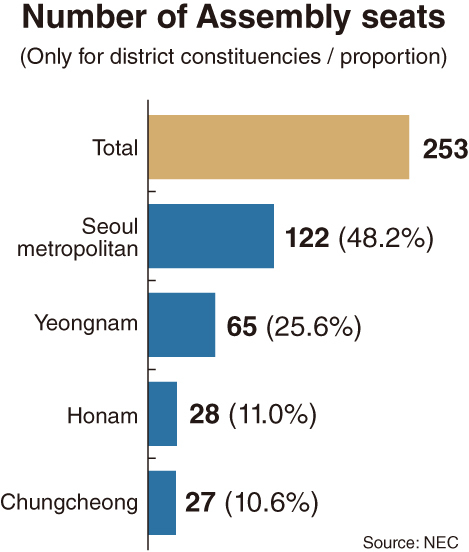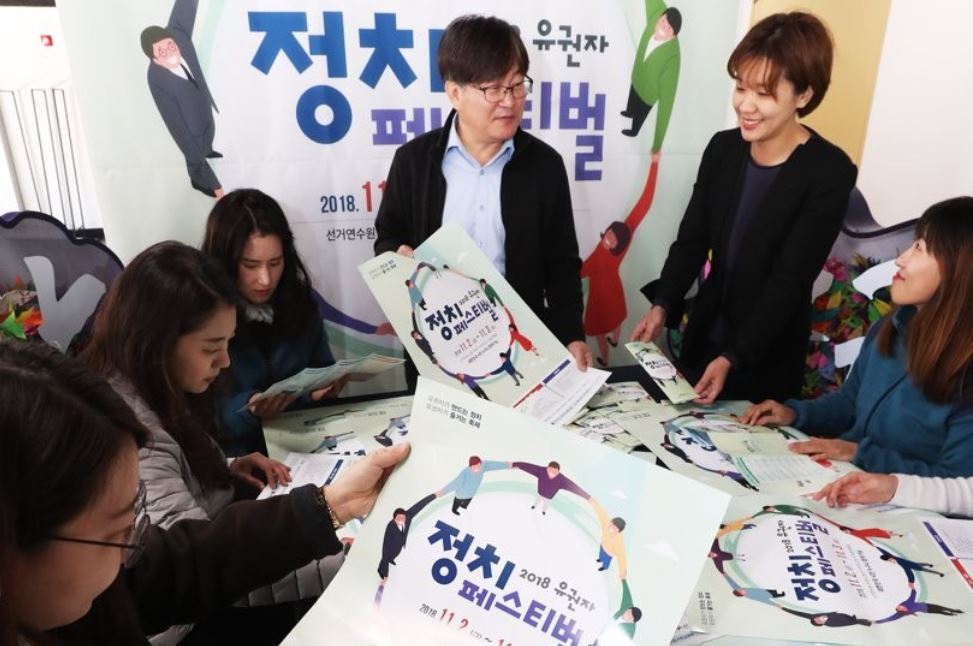[News Focus] Will Democratic Party defend its 82 seats in capital area?
By Kim Yon-sePublished : June 13, 2019 - 14:13
SEJONG -- The general election for the 21st National Assembly is coming up in about 300 days, and it will be a crucial moment when ordinary people get their chance to assess the Moon Jae-in administration.
Currently, few people expect the results of the parliamentary election to mirror those of the 2018 local elections, when the ruling Democratic Party of Korea scored a landslide victory over its main rival, the Liberty Korea Party.
Currently, few people expect the results of the parliamentary election to mirror those of the 2018 local elections, when the ruling Democratic Party of Korea scored a landslide victory over its main rival, the Liberty Korea Party.

According to a variety of pollsters, President Moon’s approval ratings hover around 40 percent despite worsened economic indices associated with employment rates, minimum wage rates, exports and apartment prices.
The approval rating for the Democratic Party ranged between 35 and 40 percent, as compared with 20-25 percent for the Liberty Korea Party.
Proponents of Moon’s policies speak highly of his efforts to ease geopolitical tensions on the peninsula and to distribute wealth more fairly via active social welfare policies.
Opponents say his economic policies have already failed and have dealt a severe blow to microbusiness owners and young job seekers. On the subject of inter-Korean talks, they say the situation is uncertain and they doubt North Korea’s promises to dismantle its nuclear facilities.
Supporters also argue that Moon faces enormous challenges as a result of the cumulative policy failures of his predecessors, former presidents Lee Myung-bak and Park Geun-hye.
But critics say Moon is 40 percent of the way through his five-year tenure and his failings should not be overlooked or excused by comparisons with former presidents.
Though voters are split on many topics, Moon’s supporters and his opponents seem to agree on one thing.
A poll from Gallup Korea, for which the results were released June 8, indicated that only 15 percent of the 1,000 respondents expected economic conditions to improve over the next year.
In contrast, 49 percent said the economy would worsen further in the coming year, while 32 percent predicted that the country’s economic situation would remain more or less the same.
The pessimists outnumbered the optimists regardless of region, age or occupation. The trend held true among students, respondents in their 30s and those from the Jeolla provinces, where support for the Democratic Party has traditionally been strong.
In the same vein, 52 percent of the 1,000 respondents said they expected to see more jobless people in the coming year, while only 19 percent forecast a drop in unemployment numbers.
The results stand in sharp contrast to those of another Gallup Korea poll, reported about a year ago in May 2018, when 35 percent of survey respondents predicted a stronger economy and only 22 percent expected it to worsen.
On the topic of the general election slated for April 15, 2020, the poll results suggested there would be neck-and-neck rivalry between the two political parties.
While 47 percent of respondents were inclined to vote for ruling party candidates who would support government policies, 40 percent leaned toward the opposition, saying the incumbent administration should face consequences for its poor performance.
A political analyst in Sejong Autonomous City forecast a revival of the long-standing regional divide between the Jeolla and Gyeongsang provinces. “There is a high possibility that the Democratic Party will surrender many of its current seats to the Liberty Korea Party in Busan and South Gyeongsang Province,” he said, citing poll results over the past few months.
In the 2016 general election for the incumbent 20th Assembly, the liberal Democratic Party held eight seats in traditionally conservative Busan and South Gyeongsang altogether.
“Further, though the ruling party is projected to sweep the Jeolla provinces, it is hard to assert an overwhelming victory in the Seoul metropolitan area and the Chungcheong area. The result will somewhat likely be different from the 2017 presidential election and the 2018 local elections,” the analyst added.
The so-called Yeongnam area -- composed of North and South Gyeongsang provinces, plus Daegu, Busan and Ulsan -- holds 65 district constituencies, according to the National Election Commission.
They include 25.6 percent of the 253 district-based seats nationwide, excluding only the 47 seats that belong to the proportional representation system.
The 28 constituencies in the Honam area -- Gwangju and the nearby South and North Jeolla provinces -- account for only 11 percent.

The Seoul capital area -- comprising Seoul, Gyeonggi Province and Incheon -- has 122 district-based seats, 48.2 percent of the total. In the 2016 general election, the Democratic Party grabbed 82 of those seats (67.2 percent), and the Saenuri Party (the predecessor of the Liberty Korea Party) won 35 seats (28.6 percent) in the most populous districts.
A survey from Realmeter, released June 11, showed that the Democratic Party posted an approval rating of 38.9 percent among people residing in Seoul, while its rival attained 32.1 percent.
But the pro-government party far outperformed the main opposition in Gyeonggi Province and Incheon: 44.6 percent versus 27.3 percent.
Meanwhile, in the previous parliamentary election, the Democratic Party (then the opposition under the Park Geun-hye government) and the Liberty Korea (Saenuri) Party took 123 and 122 seats, respectively, of the 253 constituencies across the country.
By Kim Yon-se (kys@heraldcorp.com)








![[Graphic News] More Koreans say they plan long-distance trips this year](http://res.heraldm.com/phpwas/restmb_idxmake.php?idx=644&simg=/content/image/2024/04/17/20240417050828_0.gif&u=)
![[KH Explains] Hyundai's full hybrid edge to pay off amid slow transition to pure EVs](http://res.heraldm.com/phpwas/restmb_idxmake.php?idx=644&simg=/content/image/2024/04/18/20240418050645_0.jpg&u=20240419100350)





![[From the Scene] Monks, Buddhists hail return of remains of Buddhas](http://res.heraldm.com/phpwas/restmb_idxmake.php?idx=652&simg=/content/image/2024/04/19/20240419050617_0.jpg&u=20240419175937)

![[KH Explains] Hyundai's full hybrid edge to pay off amid slow transition to pure EVs](http://res.heraldm.com/phpwas/restmb_idxmake.php?idx=652&simg=/content/image/2024/04/18/20240418050645_0.jpg&u=20240419100350)

![[Today’s K-pop] Illit drops debut single remix](http://res.heraldm.com/phpwas/restmb_idxmake.php?idx=642&simg=/content/image/2024/04/19/20240419050612_0.jpg&u=)